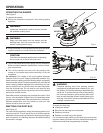
12
1-1/4"
2-1/2"
OPERATION
Fig. 6
DUST BAG
ATTACHING THE DUST BAG
See Figure 6.
The dust bag provides a dust collection system for the
sander. Sanding dust is drawn up through the holes of
the sanding disc and collected in the dust bag during
sanding.
To attach the dust bag:
Unplug the sander.
Slide dust bag assembly onto blower exhaust turning
clockwise to tighten.
ATTACHING THE SANDER TO A VACUUM
See Figure 7.
To attach the sander to a vacuum:
Unplug the sander.
Turn the dust bag counterclockwise to remove from
sander.
Attach the vacuum hose to the vacuum adaptor.
WARNING
When sander is not connected to vacuum, always
install dust bag back on sander. Failure to do so
could cause sanding dust or foreign objects to be
thrown into the face or eyes which could result in
possible serious injury.
NOTE: A standard 1-1/4 in. vacuum hose fits inside the
smaller diameter hole inside the dust exhaust, while a stan-
dard 2-1/2 in. vacuum hose connection fits inside the larger
hole of the dust exhaust.
TURNING THE SANDER ON/OFF
See Figure 8.
Depress the switch trigger to turn the sander
ON. Release
the switch trigger to turn the sander
OFF.
LOCKING ON THE SANDER
See Figure 8.
The sander is equipped with a lock-on feature, which is
convenient for continuous sanding for extended periods
of time.
WARNING:
Before connecting the sander to a power supply,
make sure it is not in the locked-on position. Failure
to do so could result in accidental starting of the
tool resulting in serious injury.
To lock on the sander:
Depress the switch trigger.
Push in the lock-on button.
Release the switch trigger.
Release the lock-on button.
NOTE: To release the lock, depress the switch trigger.
Fig. 7
VACUUM
ADAPTOR
Fig. 8
SWITCH TRIGGER
LOCK-ON BUTTON
If you have the lock-on feature engaged during use and the
sander is accidentally disconnected from the power supply,
disengage the lock-on feature immediately. Also, do not lock
the switch trigger if you might need to suddenly stop the
sander.
1-1/4 in. VACUUM HOSE
2-1/2 in. VACUUM HOSE


















